R Data Analysis Cookbook Pdf Download
Time Series Analysis
Introduction
Time series analysis has become a hot topic with the rise of quantitative finance and automated trading of securities. Many of the facilities described in this chapter were invented by practitioners and researchers in finance, securities trading, and portfolio management.
Before you start any time series analysis in R, a key decision is your choice of data representation (object class). This is especially critical in an object-oriented language such as R, because the choice affects more than how the data is stored; it also dictates which functions (methods) will be available for loading, processing, analyzing, printing, and plotting your data. When many people start using R they simply store time series data in vectors. That seems natural. However, they quickly discover that none of the coolest analytics for time series analysis work with simple vectors. We've found when users switch to using an object class intended for time series data, the analysis gets easier, opening a gateway to valuable functions and analytics.
This chapter's first recipe recommends using the zoo or xts packages for representing time series data. They are quite general and should meet the needs of most users. Nearly every subsequent recipe assumes you are using one of those two representations.
Note
The
xtsimplementation is a superset ofzoo, soxtscan do everything thatzoocan do. In this chapter, whenever a recipe works for azooobject, you can safely assume (unless stated otherwise) that it also works for anxtsobject.
Other Representations
Other representations of time series data are available in the R universe, including:
-
ftspackage -
irtsfrom thetseriespackage -
timeSeriespackage -
ts(base distribution) -
tsibblepackage, a tidyverse style package for time series
In fact, there is a whole toolkit, called tsbox, just for converting between representations.
Two representations deserve special mention.
ts (base distribution)
The base distribution of R includes a time series class called ts. We don't recommend this representation for general use because the implementation itself is too limited and restrictive.
However, the base distribution includes some important time series analytics that depend upon ts, such as the autocorrelation function (acf) and the cross-correlation function (ccf). To use those base functions on xts data, use the to.ts function to "downshift" your data into the ts representation before calling the function. For example, if x is an xts object, you can compute its autocorrelation like this:
acf(as.ts(x)) tsibble package
The tsibble package is a recent extension to the tidyverse, specifically designed for working with time series data within the tidyverse. We find it useful for cross-sectional data—that is, data for which the observations are grouped by date, and you want to perform analytics within dates more than across dates.
Date Versus Datetime
Every observation in a time series has an associated date or time. The object classes used in this chapter, zoo and xts, give you the choice of using either dates or datetimes for representing the data's time component. You would use dates to represent daily data, of course, and also for weekly, monthly, or even annual data; in these cases, the date gives the day on which the observation occurred. You would use datetimes for intraday data, where both the date and time of observation are needed.
In describing this chapter's recipes, we found it pretty cumbersome to keep saying "date or datetime." So we simplified the prose by assuming that your data are daily and thus use whole dates. Please bear in mind, of course, that you are free and able to use timestamps below the resolution of a calendar date.
Representing Time Series Data
Problem
You want an R data structure that can represent time series data.
Solution
We recommend the zoo and xts packages. They define a data structure for time series, and they contain many useful functions for working with time series data. Create a zoo object this way where x is a vector, matrix, or data frame, and dt is a vector of corresponding dates or datetimes:
Create an xts object in this way:
Convert between representations of the time series data by using as.zoo and as.xts:
-
as.zoo(ts) -
Converts
tsto azooobject -
as.xts(ts) -
Converts
tsto anxtsobject
Discussion
R has at least eight different implementations of data structures for representing time series. We haven't tried them all, but we can say that zoo and xts are excellent packages for working with time series data and better than the others that we have tried.
These representations assume you have two vectors: a vector of observations (data) and a vector of dates or times of those observations. The zoo function combines them into a zoo object:
The xts function is similar, returning an xts object:
The data, x, should be numeric. The vector of dates or datetimes, dt, is called the index. Legal indices vary between the packages:
-
zoo -
The index can be any ordered values, such as
Dateobjects,POSIXctobjects, integers, or even floating-point values. -
xts -
The index must be a supported date or time class. This includes
Date,POSIXct, andchronobjects. Those should be sufficient for most applications, but you can also useyearmon,yearqtr, anddateTimeobjects. Thextspackage is more restrictive thanzoobecause it implements powerful operations that require a time-based index.
The following example creates a zoo object that contains the price of IBM stock for the first five days of 2010; it uses Date objects for the index:
In contrast, the next example captures the price of IBM stock at one-second intervals. It represents time by the number of hours past midnight starting at 9:30 a.m. (1 second = 0.00027778 hours, more or less):
Those two examples used a single time series, where the data came from a vector. Both zoo and xts can also handle multiple, parallel time series. For this, capture the several time series in a matrix or data frame and then create a multivariate time series by calling the zoo (or xts) function:
The second argument is a vector of dates (or datetimes) for each observation. There is only one vector of dates for all the time series; in other words, all observations in each row of the matrix or data frame must have the same date. See Recipe 14.5, "Merging Several Time Series" if your data has mismatched dates.
Once the data is captured inside a zoo or xts object, you can extract the pure data via coredata, which returns a simple vector (or matrix):
You can extract the date or time portion via index:
The xts package is very similar to zoo. It is optimized for speed, so is especially well suited for processing large volumes of data. It is also clever about converting to and from other time series representations.
One big advantage of capturing data inside a zoo or xts object is that special-purpose functions become available for printing, plotting, differencing, merging, periodic sampling, applying rolling functions, and other useful operations. There is even a function, read.zoo, dedicated to reading time series data from ASCII files.
Remember that the xts package can do everything that the zoo package can do, so everywhere that this chapter talks about zoo objects you can also use xts objects.
If you are a serious user of time series data, we strongly recommend studying the documentation of these packages in order to learn about the ways they can improve your life. They are rich packages with many useful features.
See Also
See CRAN for documentation on zoo and xts, including reference manuals, vignettes, and quick reference cards. If the packages are already installed on your computer, view their documentation using the vignette function:
The timeSeries package is another good implementation of a time series object. It is part of the Rmetrics project for quantitative finance.
Plotting Time Series Data
Problem
You want to plot one or more time series.
Solution
Use plot(x), which works for zoo objects and xts objects containing either single or multiple time series.
For a simple vector v of time series observations, you can use either plot(v,type = "l") or plot.ts(v).
Discussion
The generic plot function has a version for zoo objects and xts objects. It can plot objects that contain a single time series or multiple time series. In the latter case, it can plot each series in a separate plot or together in one plot.
Suppose that ibm.infl is a zoo object that contains two time series. One shows the quoted price of IBM stock from January 2000 through December 2017, and the other is that same price adjusted for inflation. If you plot the object, R will plot the two time series together in one plot, as shown in Figure 14.1:
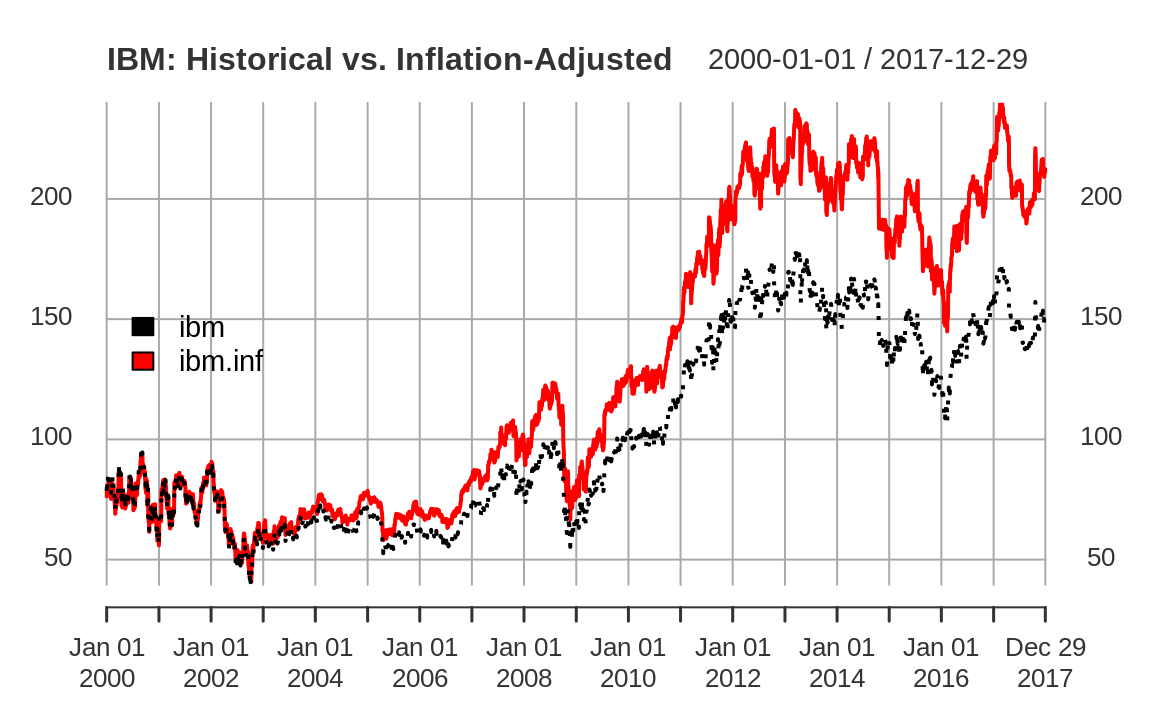
Figure 14.1: Example xts plot
The plot function for xts provides a default title as simply the name of the xts object. As we show here, it's common to set the main parameter to a more meaningful title.
The code specifies two line types (lty) so that the two lines are drawn in two different styles, making them easier to distinguish.
See Also
For working with financial data, the quantmod package contains special plotting functions that produce beautiful, stylized plots.
Extracting the Oldest or Newest Observations
Problem
You want to see only the oldest or newest observations of your time series.
Solution
Use head to view the oldest observations:
Use tail to view the newest observations:
Discussion
The head and tail functions are generic, so they will work whether your data is stored in a simple vector, a zoo object, or an xts object.
Suppose you have a xts object with a multiyear history of the price of IBM stock like the one used in the prior recipe. You can't display the whole dataset because it would scroll off your screen. But you can view the initial observations:
And you can view the final observations:
By default, head and tail show (respectively) the six oldest and six newest observations. You can see more observations by providing a second argument—for example, tail(ibm, 20).
The xts package also includes first and last functions, which use calendar periods instead of number of observations. We can use first and last to select data by number of days, weeks, months, or even years:
At first glance this output might be confusing. We asked for "2 week" and xts returned six days. That might seem off until we look at a calendar of January 2000.

Figure 14.2: January 2000 calendar
We can see from the calendar that the first week of January 2000 has only one day, Saturday the 1st. Then the second week runs from the 2nd to the 8th. Our data has no value for the 8th, so when we ask first for the first "2 week" it returns all the values from the first two calendar weeks. In our example dataset the first two calendar weeks contain only six values.
Similarly, we can ask last to give us the last month's worth of data:
If we had been using zoo objects here, we would need to have converted them to xts objects before passing the objects to first or last, as those are xts functions.
See Also
See help(first.xts) and help(last.xts) for details on the first and last functions, respectively.
Warning
The
tidyversepackagedplyralso has functions calledfirstandlast. If your workflow involves loading bothxtsanddplyrpackages, make sure to be explicit about which function you are calling by using the*package*::*function*notation (for example,xts::first).
Subsetting a Time Series
Problem
You want to select one or more elements from a time series.
Solution
You can index a zoo or xts object by position. Use one or two subscripts, depending upon whether the object contains one time series or multiple time series:
-
ts[i] -
Selects the ith observation from a single time series
-
ts[j,i] -
Selects the ith observation of the jth time series of multiple time series
You can index the time series by date. Use the same type of object as the index of your time series. This example assumes that the index contains Date objects:
You can index it by a sequence of dates:
The window function can select a range by start and end date:
Discussion
Recall our xts object that is a sample of inflation-adjusted IBM stock prices from the previous recipe:
We can select an observation by position, just like selecting elements from a vector (see Recipe 2.9, "Selecting Vector Elements"):
We can also select multiple observations by position:
Sometimes it's more useful to select by date. Simpy use the date itself as the index.
Our ibm data is an xts object, so we can use date-like subsetting, too. (The zoo object does not offer this flexibility.)
ibm['2010-01-05'] ibm['20100105'] We can also select by a vector of Date objects:
The window function is easier for selecting a range of consecutive dates:
We can select a year/month combination using yyyymm subsetting:
Select year ranges using / like so:
Or use / to select ranges including months:
See Also
The xts package provides many other clever ways to index a time series. See the package documentation.
Merging Several Time Series
Problem
You have two or more time series. You want to merge them into a single time series object.
Solution
Use a zoo or xts object to represent the time series, then use the merge function to combine them:
Discussion
Merging two time series is an incredible headache when the two series have differing timestamps. Consider these two time series: the daily price of IBM stock from 1999 through 2017, and the monthly Consumer Price Index (CPI) for the same period:
Obviously, the two time series have different timestamps because one is daily data and the other is monthly data. Even worse, the downloaded CPI data is timestamped for the first day of every month, even when that day is a holiday or weekend (e.g., New Year's Day).
Thank goodness for the merge function, which handles the messy details of reconciling the different dates:
By default, merge finds the union of all dates: the output contains all dates from both inputs, and missing observations are filled with NA values. You can replace those NA values with the most recent observation by using the na.locf function from the zoo package:
(Here locf stands for "last observation carried forward.") Observe that the NAs were replaced. However, na.locf left an NA in the first observation (1999-01-01) because there was no IBM stock price on that day.
You can get the intersection of all dates by setting all = FALSE:
Now the output is limited to observations that are common to both files.
Notice, however, that the intersection begins on February 1, not January 1. The reason is that January 1 is a holiday, so there is no IBM stock price for that date and hence no intersection with the CPI data. To fix this, see Recipe 14.6, "Filling or Padding a Time Series".
Filling or Padding a Time Series
Problem
Your time series data is missing observations. You want to fill or pad the data with the missing dates/times.
Solution
Create a zero-width (dataless) zoo or xts object with the missing dates/times. Then merge your data with the zero-width object, taking the union of all dates:
Discussion
The zoo package includes a handy feature in the constructor for zoo objects: you can omit the data and build a zero-width object. The object contains no data, just dates. We can use these "Frankenstein" objects to perform such operations as filling and padding on other time series objects.
Suppose you download monthly CPI data used in the last recipe. The data is timestamped with the first day of each month:
As far as R knows, we have no observations for the other days of the months. However, we know that each CPI value applies to the subsequent days through month-end. So first we build a zero-width object with every day of the decade, but no data:
We use the min(index(cpi)) and max(index(cpi)) to get the minimum and maximum index value from our cpidata. So our resulting empty object is just an index of daily dates with the same range as our cpi data.
Then we take the union the CPI data and the zero-width object, yielding a dataset filled with NA values:
The resulting time series contains every calendar day, with NAs where there was no observation. That might be what you need. However, a more common requirement is to replace each NA with the most recent observation as of that date. The na.locf function from the zoo package does exactly that:
January's value of 1 is carried forward until February 1, at which time it is replaced by the February value. Now every day has the latest CPI value as of that date. Note that in this dataset, the CPI is based on January 1, 1999 = 100% and all CPI values are relative to the value on that date.
We can use this recipe to fix the problem mentioned in Recipe 14.5, "Merging Several Time Series". There, the daily price of IBM stock and the monthly CPI data had no intersection on certain days. We can fix that using several different methods. One way is to pad the IBM data to include the CPI dates and then take the intersection (recall that index(cpi) returns all the dates in the CPI time series):
That gives monthly observations. Another way is to fill out the CPI data (as described previously) and then take the intersection with the IBM data. That gives daily observations, as follows:
Another common method for filling missing values uses the cubic spline technique, which interpolates smooth intermediate values from the known data. We can use the zoo function na.spline to fill our missing values using a cubic spline.
Notice that both the missing values for cpi and ibm were filled. However, the value filled in for January 1, 1999 for the ibm column seems out of line with the January 4th observation. This illustrates one of the challenges with cubic splines: they can become quite unstable if the value that is being interpolated is at the very beginning or the very end of a series. To get around this instability, we could get some data points from before January 1st, 1999, then interpolate using na.spline, or we could simply choose a different interpolation method.
Lagging a Time Series
Problem
You want to shift a time series in time, either forward or backward.
Solution
Use the lag function. The second argument, k, is the number of periods to shift the data:
Use positive k to shift the data forward in time (tomorrow's data becomes today's data). Use a negative k to shift the data backward in time (yesterday's data becomes today's data).
Discussion
Recall the zoo object containing five days of IBM stock prices from Recipe 14.1, "Representing Time Series Data":
To shift the data forward one day, we use k = +1:
We also set na.pad = TRUE to fill the trailing dates with NA. Otherwise, they would simply be dropped, resulting in a shortened time series.
To shift the data backward one day, we use k = -1. Again we use na.pad = TRUE to pad the beginning with NAs:
If the sign convention for k seems odd to you, you are not alone.
Warning
The function is called
lag, but a positivekactually generates leading data, not lagging data. Use a negativekto get lagging data. Yes, this is bizarre. Perhaps the function should have been calledlead.
The other thing to be careful with when using lag is that the dplyr package contains a function named lag as well. The arguments for dplyr::lag are not exactly the same as the Base R lag function. In particular, dplyr uses n instead of k:
Warning
If you want to load
dplyr, you should use the namespace to be explicit about whichlagfunction you are using. The Base R function isstats::lag, while the dplyr function is, naturally,dplyr::lag.
Computing Successive Differences
Problem
Given a time series, x, you want to compute the difference between successive observations: (x 2 – x 1), (x 3 – x 2), (x 4 – x 3), ….
Solution
Use the diff function:
Discussion
The diff function is generic, so it works on simple vectors, xts objects, and zoo objects. The beauty of differencing a zoo or xts object is that the result is the same type object you started with and the differences have the correct dates. Here we compute the differences for successive prices of IBM stock:
The difference labeled 2010-01-05 is the change from the previous day (2010-01-04), which is usually what you want. The differenced series is shorter than the original series by one element because R can't compute the change as of 2010-01-04, of course.
By default, diff computes successive differences. You can compute differences that are more widely spaced by using its lag parameter. Suppose you have monthly CPI data and want to compute the change from the previous 12 months, giving the year-over-year change. Specify a lag of 12:
Performing Calculations on Time Series
Problem
You want to use arithmetic and common functions on time series data.
Solution
No problem. R is pretty clever about operations on zoo and xts objects. You can use arithmetic operators (+, -, *, /, etc.) as well as common functions (sqrt, log, etc.) and usually get what you expect.
Discussion
When you perform arithmetic on zoo or xts objects, R aligns the objects according to date so that the results make sense. Suppose we want to compute the percentage change in IBM stock. We need to divide the daily change by the price, but those two time series are not naturally aligned—they have different start times and different lengths. Here's an illustration with a zoo object:
Fortunately, when we divide one series by the other, R aligns the series for us and returns a zoo object:
We can scale the result by 100 to compute the percentage change, and the result is another zoo object:
Functions work just as well. If we compute the logarithm or square root of a zoo object, the result is a zoo object with the timestamps preserved:
In investment management, computing the difference of logarithms of prices is quite common. That's a piece of cake in R:
Computing a Moving Average
Problem
You want to compute the moving average of a time series.
Solution
Use the rollmean function of the zoo package to calculate the k-period moving average:
Here ts is the time series data, captured in a zoo object, and k is the number of periods.
For most financial applications, you want rollmean to calculate the mean using only historical data; that is, for each day, use only the data available that day. To do that, specify align = right. Otherwise, rollmean will "cheat" and use future data that was actually unavailable at the time:
Discussion
Traders are fond of moving averages for smoothing out fluctuations in prices. The formal name is the rolling mean. You could calculate the rolling mean as described in Recipe 14.12, "Applying a Rolling Function", by combining the rollapply function and the mean function, but rollmean is much faster.
Beside speed, the beauty of rollmean is that it returns the same type of time series object it's called on (i.e., xts or zoo). For each element in the object, its date is the "as of" date for a calculated mean. Because the result is a time series object, you can easily merge the original data and the moving average and then plot them together as in Figure 14.3:
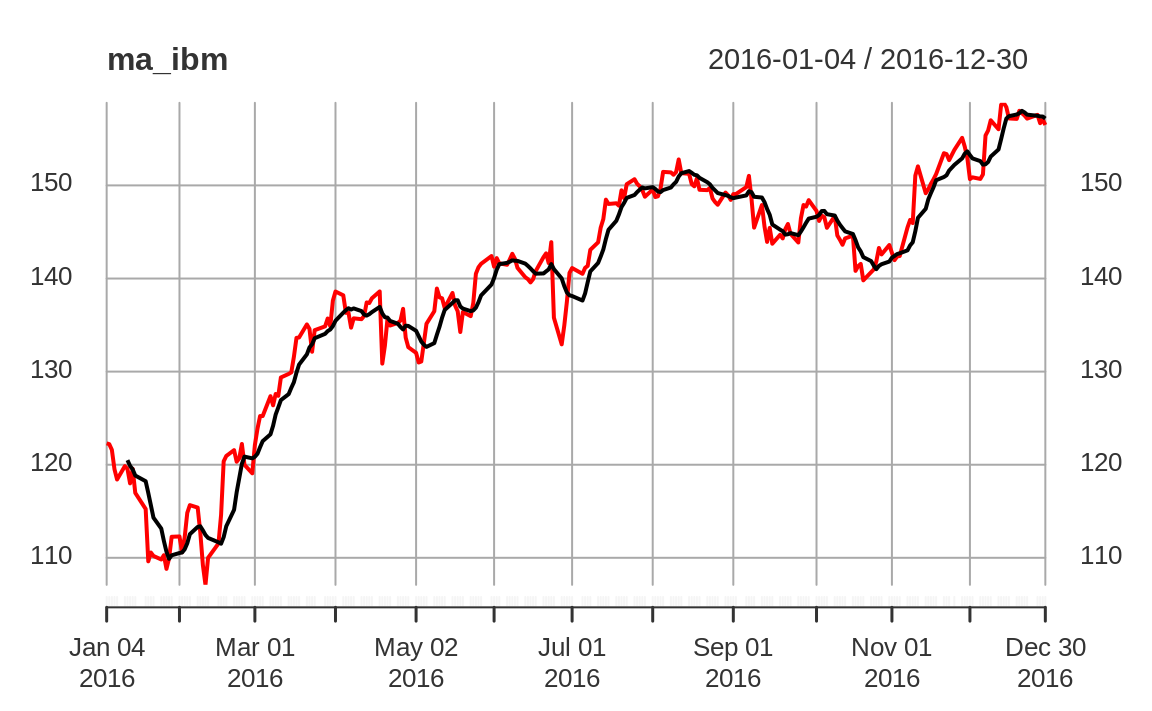
Figure 14.3: Rolling average plot
The output is normally missing a few initial data points, since rollmean needs a full k observations to compute the mean. Consequently, the output is shorter than the input. If that's a problem, specify na.pad = TRUE; then rollmean will pad the initial output with NA values.
See Also
See Recipe 14.12, "Applying a Rolling Function", for more about the align parameter.
The moving average described here is a simple moving average. The quantmod, TTR, and fTrading packages contain functions for computing and plotting many kinds of moving averages, including simple ones.
Applying a Function by Calendar Period
Problem
Given a time series, you want to group the contents by a calendar period (e.g., week, month, or year) and then apply a function to each group.
Solution
The xts package includes functions for processing a time series by day, week, month, quarter, or year:
Here ts is an xts time series, and f is the function to apply to each day, week, month, quarter, or year.
If your time series is a zoo object, convert to an xts object first so you can access these functions; for example:
Discussion
It is common to process time series data according to calendar period. But figuring calendar periods is tedious at best and bizarre at worst. Let these functions do the heavy lifting.
Suppose we have a five-year history of IBM stock prices stored in an xts object:
We can calculate the average price by month if we use apply.monthly and mean together:
Notice that the IBM data is in an xts object from the start. Had the data been in a zoo object, we would have needed to convert it to xts using as.xts.
A more interesting application is calculating volatility by calendar month, where volatility is measured as the standard deviation of daily log-returns. Daily log-returns are calculated this way:
We calculate their standard deviation, month by month, like this:
We can scale the daily number to estimate annualized volatility, as shown in Figure 14.4:

Figure 14.4: IBM volatility plot
Applying a Rolling Function
Problem
You want to apply a function to a time series in a rolling manner: calculate the function at a data point using some window of time around that point, move to the next data point, calculate the function around that point, move to the next data point, and so forth.
Solution
Use the rollapply function in the zoo package. The width parameter defines how many data points from the time series (ts) should be processed by the function (f) at each point:
For many applications, you will likely set align = "right" to avoid computing f with historical data that was unavailable at the time:
Discussion
The rollapply function extracts a "window" of data from your time series, calls your function with that data, saves the result, and moves to the next window—and repeats this pattern for the entire input. As an illustration, consider calling rollapply with width = 21:
rollapply will repeatedly call the function, f, with a sliding window of data, like this:
-
f(ts[1:21]) -
f(ts[2:22]) -
f(ts[3:23]) -
…
etc.…
Observe that the function should expect one argument, which is a vector of values. rollapply will save the returned values before packaging them into a zoo object along with a timestamp for every value. The choice of timestamp depends on the align parameter given to rollapply:
-
align="right" -
The timestamp is taken from the rightmost value.
-
align="left" -
The timestamp is taken from the leftmost value.
-
align="center" (default) -
The timestamp is taken from the middle value.
By default, rollapply will recalculate the function at successive data points. You may instead want to calculate the function at every nth data point. Use the by = n parameter to have rollapply move ahead n points after each function call. When we calculate the rolling standard deviation of a time series, for example, we usually want each window of data to be separate, not overlapping, so we set the by value equal to the window size:
The rollapply function will, by default, return an object with as many observations as your input data with the missing values filled with NA. In the preceding example we use na.omit to drop the NA values so that our resulting object has records only for the dates for which we have values.
Plotting the Autocorrelation Function
Problem
You want to plot the autocorrelation function (ACF) of your time series.
Solution
Use the acf function:
Discussion
The autocorrelation function is an important tool for revealing the interrelationships within a time series. It is a collection of correlations, \(\rho_k\) for k = 1, 2, 3, …, where \(\rho_k\) is the correlation between all pairs of data points that are exactly k steps apart.
Visualizing the autocorrelations is much more useful than listing them, so the acf function plots them for each value of k. The following example shows the autocorrelation functions for two time series, one with autocorrelations and one without. The dashed line delimits the significant and insignificant correlations: values above the line are significant. (The height of the dashed line in Figures 14.5 and 14.6 is determined by the amount of data.)
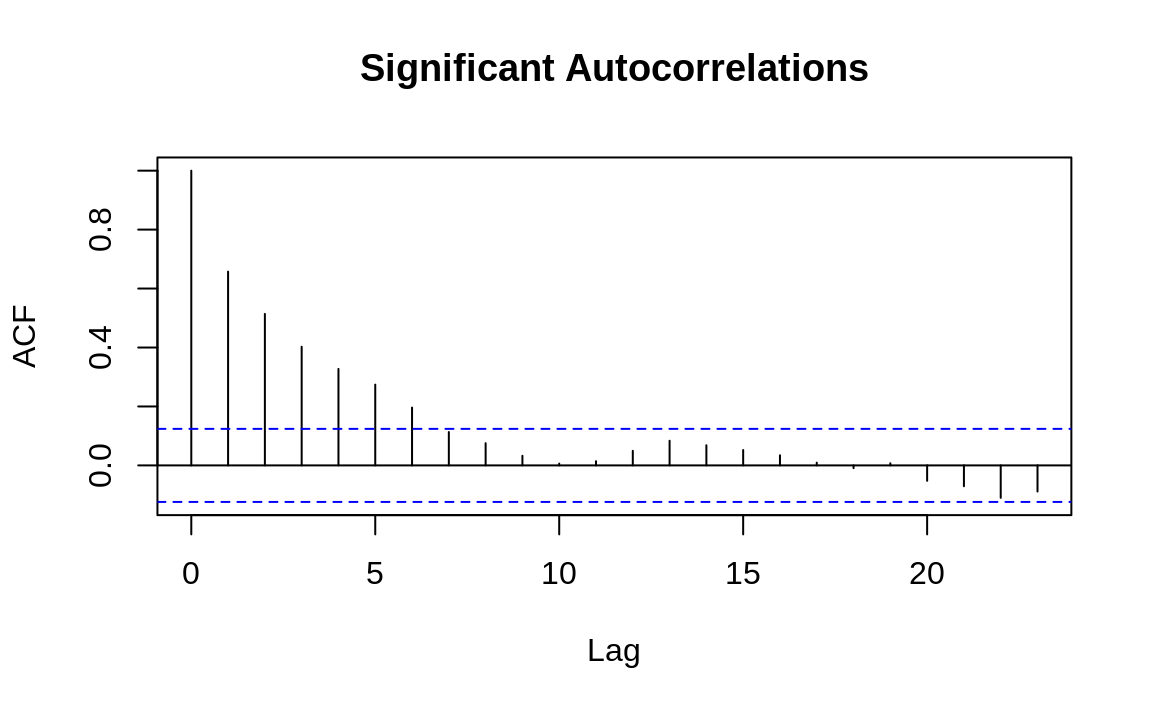
Figure 14.5: Autocorrelations at each lag: ts1
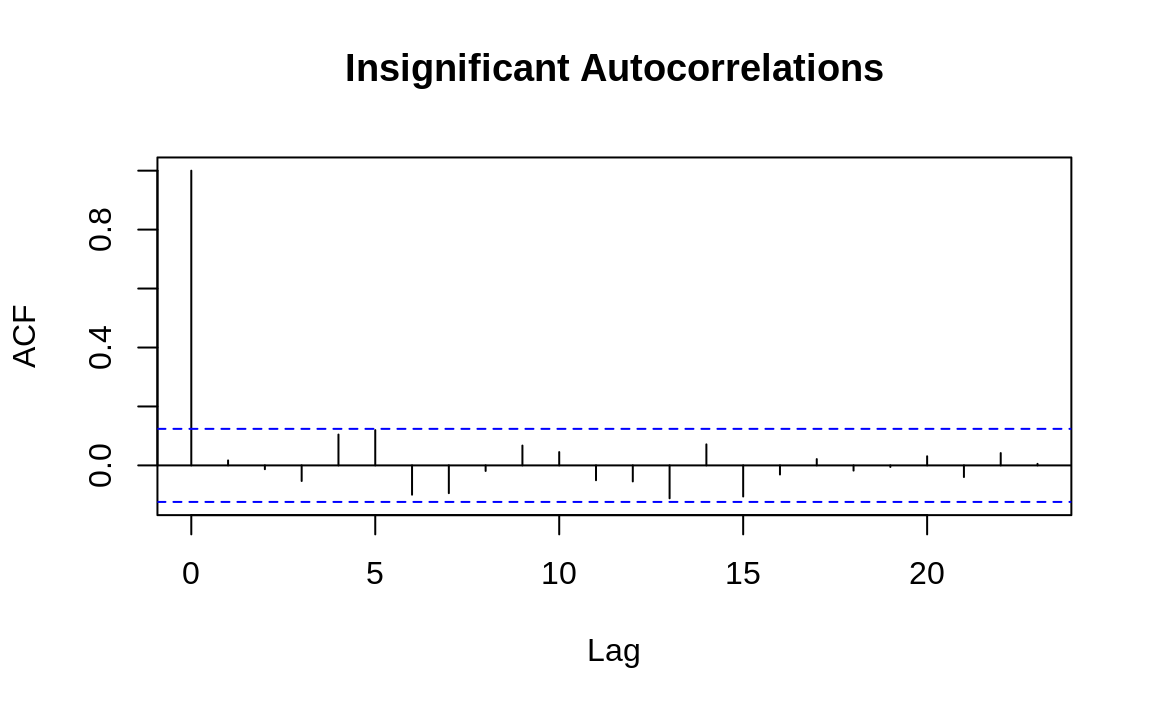
Figure 14.6: Autocorrelations at each lag: ts2
The presence of autocorrelations is one indication that an autoregressive integrated moving average (ARIMA) model could model the time series. From the ACF, you can count the number of significant autocorrelations, which is a useful estimate of the number of moving average (MA) coefficients in the model. Figure 14.5 shows seven significant autocorrelations, for example, so we estimate that its ARIMA model will require seven MA coefficients (MA(7)). That estimate is just a starting point, however, and must be verified by fitting and diagnosing the model.
Testing a Time Series for Autocorrelation
Problem
You want to test your time series for the presence of autocorrelations.
Solution
Use the Box.test function, which implements the Box–Pierce test for autocorrelation:
The output includes a p-value. Conventionally, a p-value of less than 0.05 indicates that the data contains significant autocorrelations, whereas a p-value exceeding 0.05 provides no such evidence.
Discussion
Graphing the autocorrelation function is useful for digging into your data. Sometimes, however, we just need to know whether or not the data is autocorrelated. A statistical test such as the Box–Pierce test can provide an answer.
We can apply the Box–Pierce test to the data whose autocorrelation function we plotted in Recipe 14.13, "Plotting the Autocorrelation Function". The test shows p-values for the two time series that are nearly 0 and 0.79, respectively:
The p-value near 0 indicates that the first time series has significant autocorrelations. (We don't know which autocorrelations are significant; we just know they exist.) The p-value of 0.8 indicates that the test did not detect autocorrelations in the second time series.
The Box.test function can also perform the Ljung–Box test, which is better for small samples. That test calculates a p-value whose interpretation is the same as that for the Box–Pierce p-value:
Plotting the Partial Autocorrelation Function
Problem
You want to plot the partial autocorrelation function (PACF) for your time series.
Solution
Use the pacf function:
Discussion
The partial autocorrelation function is another tool for revealing the interrelationships in a time series. However, its interpretation is much less intuitive than that of the autocorrelation function. We'll leave the mathematical definition of partial correlation to a textbook on statistics. Here, we'll just say that the partial correlation between two random variables, X and Y, is the correlation that remains after accounting for the correlation shown by X and Y, with all other variables. In the case of time series, the partial autocorrelation at lag k is the correlation between all data points that are exactly k steps apart—after accounting for their correlation with the data between those k steps.
The practical value of a PACF is that it helps you to identify the number of autoregression (AR) coefficients in an ARIMA model. The following example shows the PACF for the two time series used in Recipe 14.13, "Plotting the Autocorrelation Function". One of these series has partial autocorrelations and one does not. Lag values whose lines cross above the dotted line are statistically significant. In the first time series (Figure 14.7) there are two such values, at k = 1 and k = 2, so our initial ARIMA model will have two AR coefficients (AR(2)). As with autocorrelation, however, that is just an initial estimate and must verified by fitting and diagnosing the model. The second time series (Figure 14.8) shows no such autocorrelation pattern.
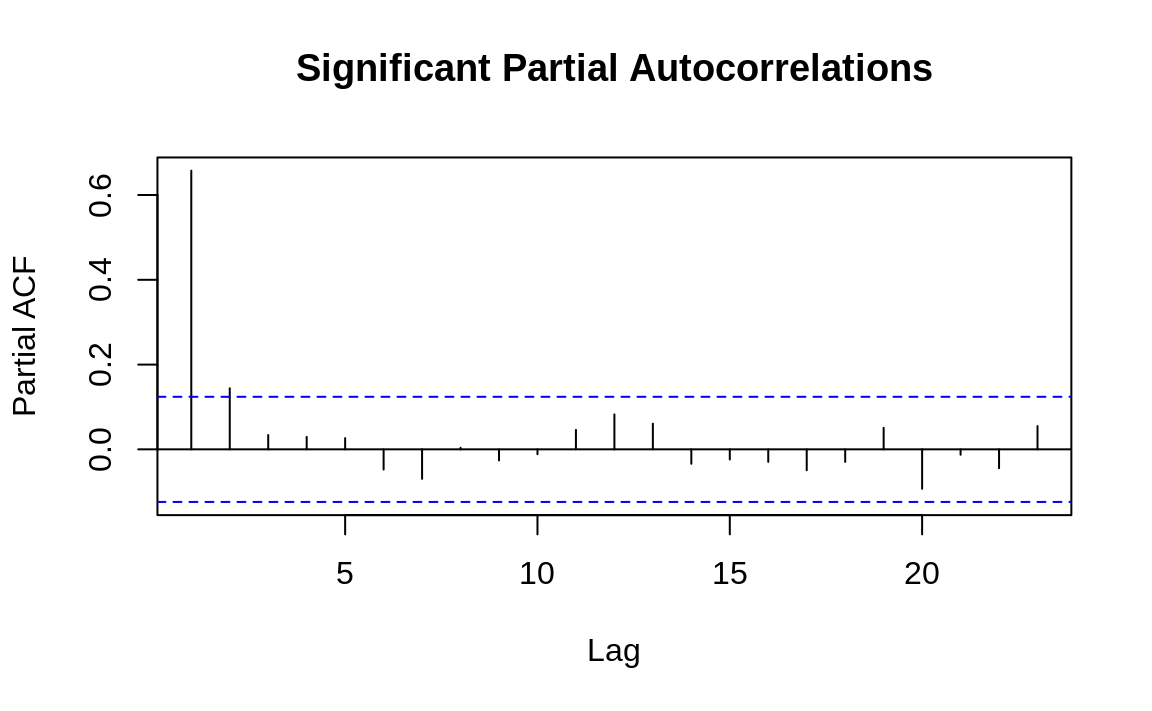
Figure 14.7: Autocorrelations at each lag: ts1
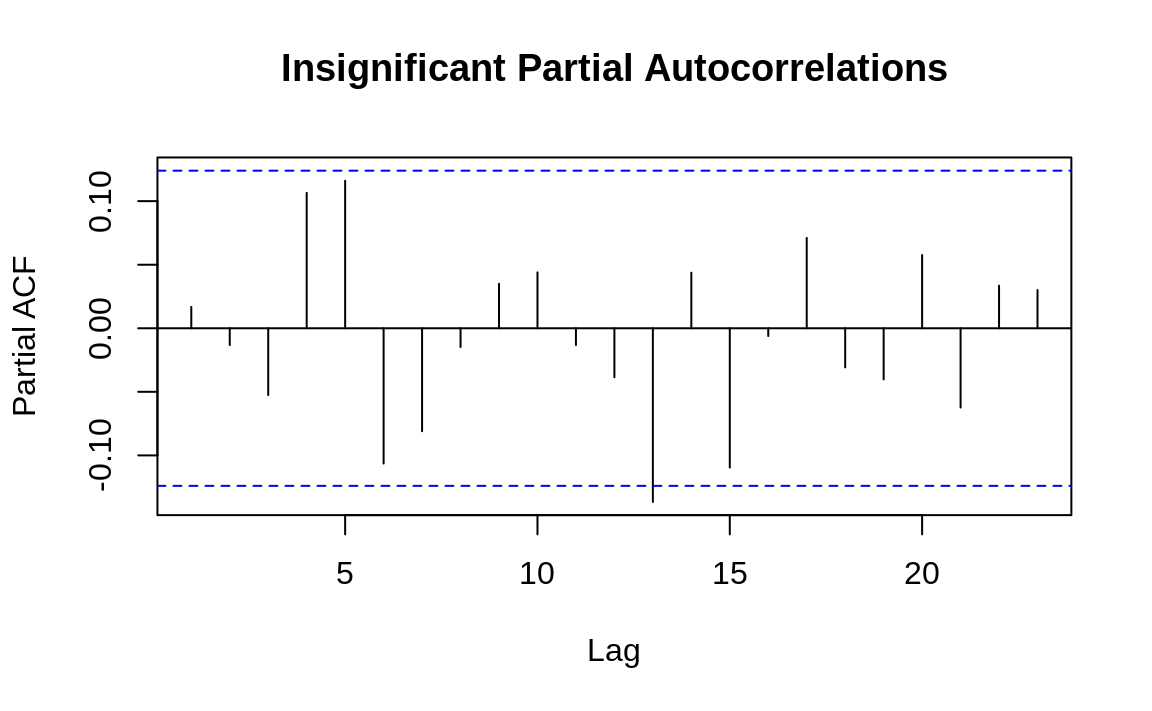
Figure 14.8: Autocorrelations at each lag: ts2
Finding Lagged Correlations Between Two Time Series
Problem
You have two time series, and you are wondering if there is a lagged correlation between them.
Solution
Use the Ccf function from the package forecast to plot the cross-correlation function, which will reveal lagged correlations:
Discussion
The cross-correlation function helps you discover lagged correlations between two time series. A lagged correlation occurs when today's value in one time series is correlated with a future or past value in the other time series.
Consider the relationship between commodity prices and bond prices. Some analysts believe those prices are connected because changes in commodity prices are a barometer of inflation, one of the key factors in bond pricing. Can we discover a correlation between them?
Figure 14.9 shows a cross-correlation function generated from daily changes in bond prices and a commodity price index:5
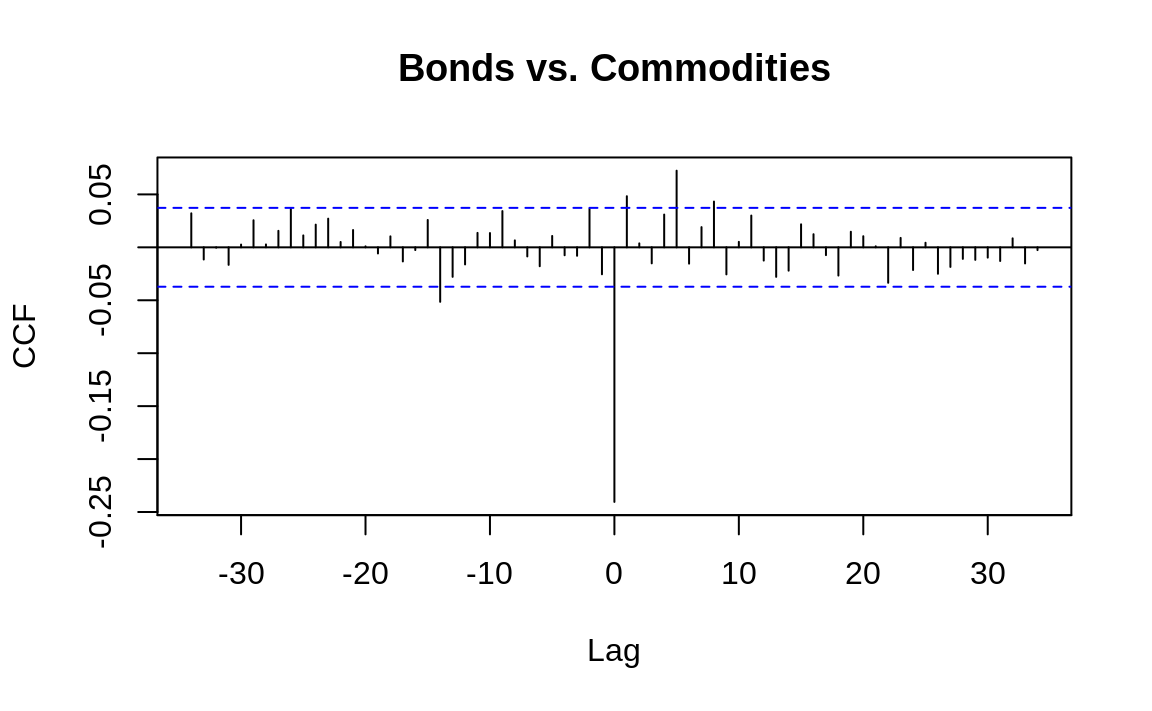
Figure 14.9: Cross-correlation function
Note that since the objects we start with, bonds and cmdtys, are xts objects, we extract from each the vector of data using coredata()[1]. This is because the Ccf function expects inputs to be simple vectors.
Every vertical line shows the correlation between the two time series at some lag, as indicated along the x-axis. If a correlation extends above or below the dotted lines, it is statistically significant.
Notice that the correlation at lag 0 is –0.24, which is the simple correlation between the variables:
Much more interesting are the correlations at lags 1, 5, and 8, which are statistically significant. Evidently there is some "ripple effect" in the day-to-day prices of bonds and commodities because changes today are correlated with changes tomorrow. Discovering this sort of relationship is useful to short-term forecasters such as market analysts and bond traders.
Detrending a Time Series
Problem
Your time series data contains a trend that you want to remove.
Solution
Use linear regression to identify the trend component, and then subtract the trend component from the original time series. These two lines show how to detrend the zoo object ts and put the result in detr:
Discussion
Some time series data contains trends, which means that it gradually slopes upward or downward over time. Suppose your time series object (a zoo object in this case), yield, contains a trend as shown in Figure 14.10:
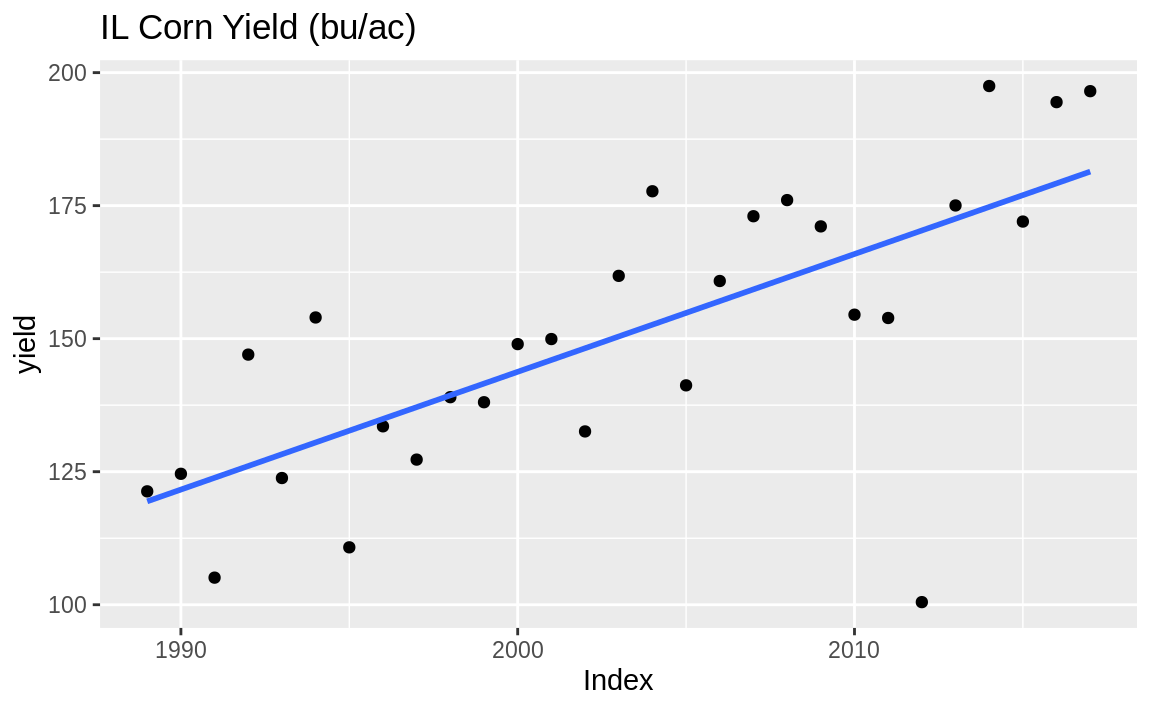
Figure 14.10: Time series with trend
We can remove the trend component in two steps. First, identify the overall trend by using the linear model function, lm. The model should use the time series index for the x variable and the time series data for the y variable.
Second, remove the linear trend from the original data by subtracting the straight line found by lm. This is easy because we have access to the linear model's residuals, which are defined by the difference between the original data and the fitted line:
\(r_i = y_i - \beta_1 x_i - \beta_0\)
where \(r_i\) is the ith residual, and where \(\beta_1\) and \(\beta_0\) are the model's slope and intercept, respectively. We can extract the residuals from the linear model by using the resid function and then embed the residuals inside a zoo object:
Notice that we use the same time index as the original data. When we plot detr it is clearly trendless, as evident in Figure 14.11.
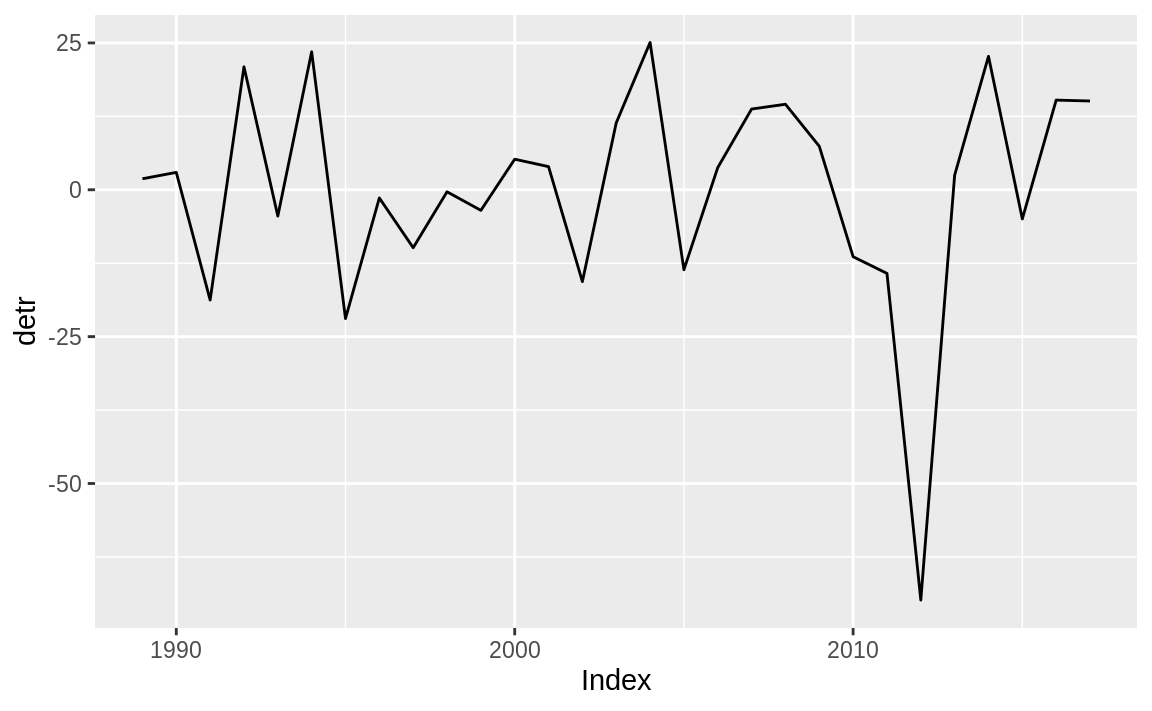
Figure 14.11: Residual plot
This data is the state average corn yield for Illinois in bushels per acre (bu/ac). So detr is the difference between actual yield and the trend. Sometimes when detrending you may want to determine the percent deviation from the trend. In that case we can divide by the initial measure:
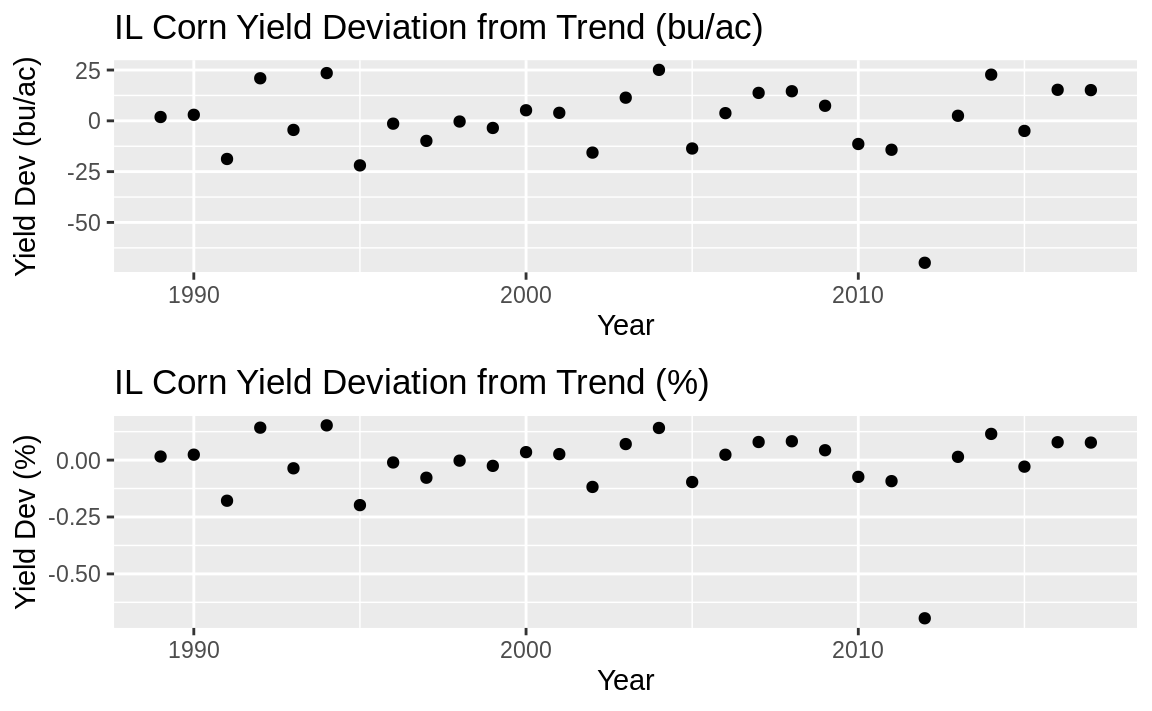
Figure 14.12: Detrended plots
The top plot in Figure 14.12 shows the yield deviation from the trend in bu/ac (the original units), while the lower plot shows the percent deviation from the trend.
Fitting an ARIMA Model
Problem
You want to fit an ARIMA model to your time series data.
Solution
The auto.arima function in the forecast package can select the correct model order and fit the model to your data:
If you already know the model order, (p, d, q), then the arima function can fit the model directly:
Discussion
Creating an ARIMA model involves three steps:
-
Identify the model order.
-
Fit the model to the data, giving the coefficients.
-
Apply diagnostic measures to validate the model.
The model order is usually denoted by three integers, (p, d, q), where p is the number of autoregressive coefficients, d is the degree of differencing, and q is the number of moving average coefficients.
When most of us build an ARIMA model, we are usually clueless about the appropriate order. Rather than tediously searching for the best combination of p, d, and q, we typically use auto.arima, which does the searching for us:
In this case, auto.arima decided the best order was (1, 1, 2), which means that it differenced the data once (d = 1) before selecting a model with AR coefficients (p = 1) and two MA coefficients (q = 2). In addition, the auto.arima function determined that our data has seasonality and included the seasonal terms P = 0, D = 1, Q = 1 and a period of m = 4. The seasonality terms are similar to the nonseasonal ARIMA terms, but relate to the seasonality component of the model. The m term tells us the periodicity of the seasonality, which in this case is quarterly. We can see this easier if we plot the ausbeer data as in Figure 14.13:
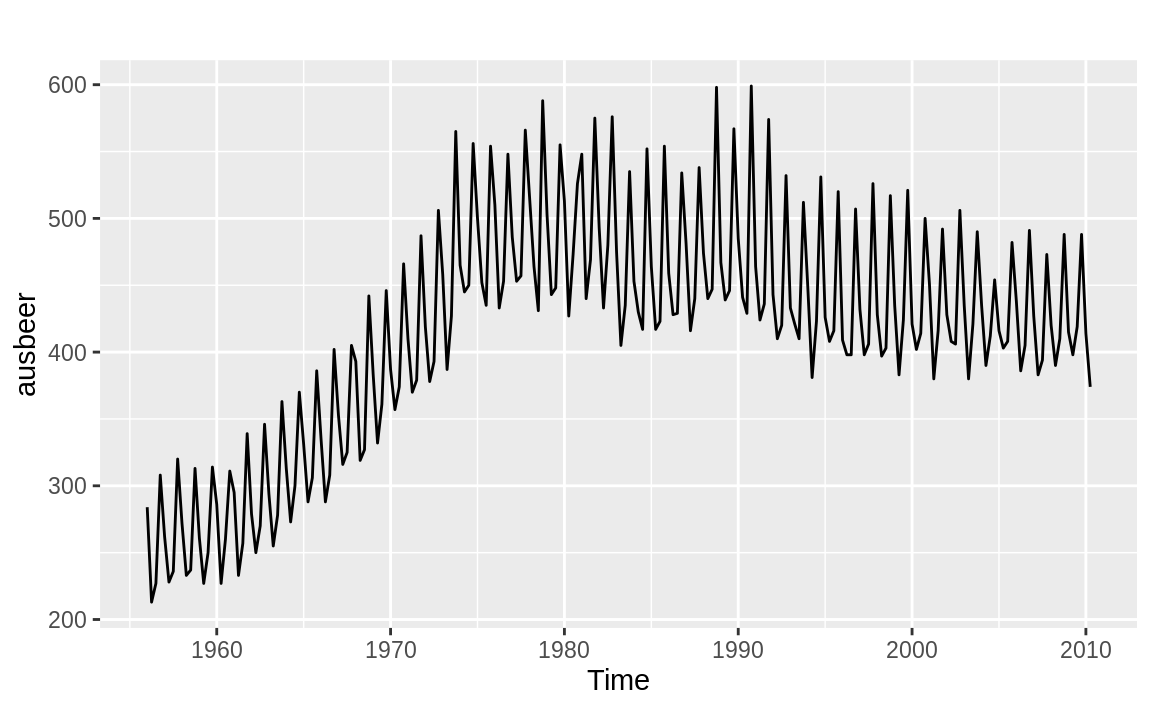
Figure 14.13: Australian beer consumption
By default, auto.arima limits p and q to the range 0 ≤ p ≤ 5 and 0 ≤ q ≤ 5. If you are confident that your model needs fewer than five coefficients, use the max.p and max.q parameters to limit the search further; this makes it faster. Likewise, if you believe that your model needs more coefficients, use max.p and max.q to expand the search limits.
If you want to turn off the seasonality component of auto.arima, you can set seasonal = FALSE:
But notice that since the model fits a nonseasonal model, the coefficients are different than in the seasonal model.
If you already know the order of your ARIMA model, the arima function can quickly fit the model to your data:
The output looks identical to auto.arima with the seasonal parameter set to FALSE. What you can't see here is that arima executes much more quickly.
The output from auto.arima and arima includes the fitted coefficients and the standard error (s.e.) for each coefficient:
Coefficients: ar1 ar2 ar3 ma1 ma2 -0.9569 -0.9872 -0.9247 -1.0425 0.1416 s.e. 0.0257 0.0184 0.0242 0.0619 0.0623 You can find the coefficients' confidence intervals by capturing the ARIMA model in an object and then using the confint function:
This output illustrates a major headache of ARIMA modeling: not all the coefficients are necessarily significant. If one of the intervals contains zero, the true coefficient might be zero itself, in which case the term is unnecessary.
If you discover that your model contains insignificant coefficients, use Recipe 14.19, "Removing Insignificant ARIMA Coefficients", to remove them.
The auto.arima and arima functions contain useful features for fitting the best model. For example, you can force them to include or exclude a trend component. See the help pages for details.
A final caveat: the danger of auto.arima is that it makes ARIMA modeling look simple. ARIMA modeling is not simple. It is more art than science, and the automatically generated model is just a starting point. We urge you to review a good book about ARIMA modeling before settling on a final model.
Removing Insignificant ARIMA Coefficients
Problem
One or more of the coefficients in your ARIMA model are statistically insignificant. You want to remove them.
Solution
The arima function includes the parameter fixed, which is a vector. The vector should contain one element for every coefficient in the model, including a term for the drift (if any). Each element is either NA or 0. Use NA for the coefficients to be kept and use 0 for the coefficients to be removed. This example shows an ARIMA(2, 1, 2) model with the first AR coefficient and the first MA coefficient forced to be 0:
Discussion
The fpp2 package contains a dataset called euretail, which is a quarterly retail index for the Euro area. Let's run auto.arima on the data and look at the 98% confidence intervals:
In this example, we can see that the 98% confidence interval for the ma1 parameter contains 0 and we can reasonably conclude that this parameter is insignificant at this level of confidence. We can set this parameter to 0 using the fixed parameter:
m <- arima(euretail, order = c(0, 1, 3), seasonal = c(0, 1, 1), fixed = c(0, NA, NA, NA)) m #> #> Call: #> arima(x = euretail, order = c(0, 1, 3), seasonal = c(0, 1, 1), fixed = c(0, #> NA, NA, NA)) #> #> Coefficients: #> ma1 ma2 ma3 sma1 #> 0 0.404 0.293 -0.700 #> s.e. 0 0.129 0.107 0.135 #> #> sigma^2 estimated as 0.156: log likelihood = -30.8, aic = 69.5 Observe that the ma1 coefficient is now 0. The remaining coefficients (ma2, ma3, sma1) are still significant, as shown by their confidence intervals, so we have a reasonable model:
Running Diagnostics on an ARIMA Model
Problem
You have built an ARIMA model using the forecast package, and you want to run diagnostic tests to validate the model.
Solution
Use the checkresiduals function. This example fits the ARIMA model using auto.arima, puts the results in m, and then runs diagnostics on the model:
Discussion
The result of checkresiduals is a set of three graphs, as shown in Figure 14.14. A good model should produce results like these:
#> #> Ljung-Box test #> #> data: Residuals from ARIMA(1,1,2)(0,1,1)[4] #> Q* = 5, df = 4, p-value = 0.3 #> #> Model df: 4. Total lags used: 8 
Figure 14.14: Residuals plots: Good model
Here's what's good about the graphs:
-
The standardized residuals don't show clusters of volatility.
-
The autocorrelation function (ACF) shows no significant autocorrelation between the residuals.
-
The residuals look bell-shaped, suggesting they are reasonably symmetrical.
-
The p-value in the Ljung–Box test is large, indicating that the residuals are patternless—meaning all the information has been extracted by the model and only noise is left behind.
For contrast, Figure 14.15 shows diagnostic charts with problems:
#> #> Ljung-Box test #> #> data: Residuals from ARIMA(1,1,1)(0,0,1)[4] #> Q* = 22, df = 5, p-value = 5e-04 #> #> Model df: 3. Total lags used: 8 
Figure 14.15: Residuals plots: Problem model
-
The ACF shows significant autocorrelations between residuals.
-
The p-values for the Ljung–Box statistics are small, indicating there is some pattern in the residuals. There is still information to be extracted from the data.
-
The residuals appear asymmetrical.
These are basic diagnostics, but they are a good start. Find a good book on ARIMA modeling and perform the recommended diagnostic tests before concluding that your model is sound. Additional checks of the residuals could include:
- Tests for normality
- Quantile–quantile (Q–Q) plot
- Scatter plot against the fitted values
Making Forecasts from an ARIMA Model
Problem
You have an ARIMA model for your time series that you built with the forecast package. You want to forecast the next few observations in the series.
Solution
Save the model in an object, and then apply the forecast function to the object. This example saves the model from Recipe 14.19, "Removing Insignificant ARIMA Coefficients", and predicts the next eight observations:
m <- arima(euretail, order = c(0, 1, 3), seasonal = c(0, 1, 1), fixed = c(0, NA, NA, NA)) forecast(m) #> Point Forecast Lo 80 Hi 80 Lo 95 Hi 95 #> 2012 Q1 95.1 94.6 95.6 94.3 95.9 #> 2012 Q2 95.2 94.5 95.9 94.1 96.3 #> 2012 Q3 95.2 94.2 96.3 93.7 96.8 #> 2012 Q4 95.3 93.9 96.6 93.2 97.3 #> 2013 Q1 94.5 92.8 96.1 91.9 97.0 #> 2013 Q2 94.5 92.6 96.5 91.5 97.5 #> 2013 Q3 94.5 92.3 96.7 91.1 97.9 #> 2013 Q4 94.5 92.0 97.0 90.7 98.3 Discussion
The forecast function will calculate the next few observations and their standard errors according to the model. It returns a list with 10 elements. When we print the model, as we just did, forecast returns the time series points it is forecasting, the forecast, and two pairs of confidence bands: high/low 80% and high/low 95%.
If we want to extract out just the forecast, we can do that by assigning the results to an object, and then pulling out the list item named mean:
The result is a Time-Series object containing the forecasts created by the forecast function.
Plotting a Forecast
Problem
You have created a time series forecast with the forecast package and you would like to plot it.
Solution
Time series models created with the forecast package have a plotting method that uses ggplot2 to create graphs easily, as shown in Figure 14.16:

Figure 14.16: Forecast cone of uncertainty: Default
Discussion
The autoplot function makes a very reasonable figure, as shown in Figure 14.16. Since the resulting figure is a ggplot object, we can adjust the plotting parameters the same way we would any other ggplot object. Here we add labels and a title and change the theme, as shown in Figure 14.17:
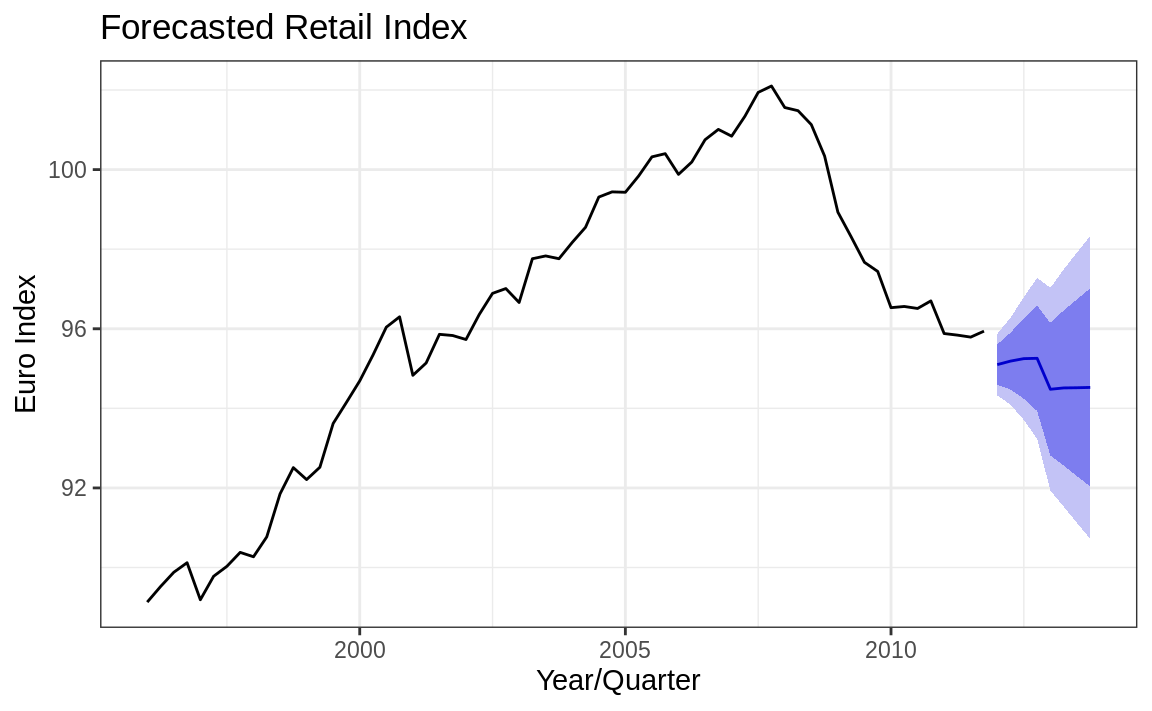
Figure 14.17: Forecast cone of uncertainty: Labeled
See Also
Chapter @ref(#Graphics) for more info on working with ggplot figures.
Testing for Mean Reversion
Problem
You want to know if your time series is mean reverting (stationary).
Solution
A common test for mean reversion is the Augmented Dickey–Fuller (ADF) test, which is implemented by the adf.test function of the tseries package:
The output from adf.test includes a p-value. Conventionally, if p < 0.05, the time series is likely mean reverting, whereas a p > 0.05 provides no such evidence.
Discussion
When a time series is mean reverting, it tends to return to its long-run average. It may wander off, but eventually it wanders back. If a time series is not mean reverting, then it can wander away without ever returning to the mean.
Figure 14.18 appears to be wandering upward and not returning. The large p-value from the adf.test confirms that it is not mean reverting:

Figure 14.18: Time series without mean reversion
The time series in Figure 14.19, however, is just bouncing around its average value. The small p-value (0.012) confirms that it is mean reverting:
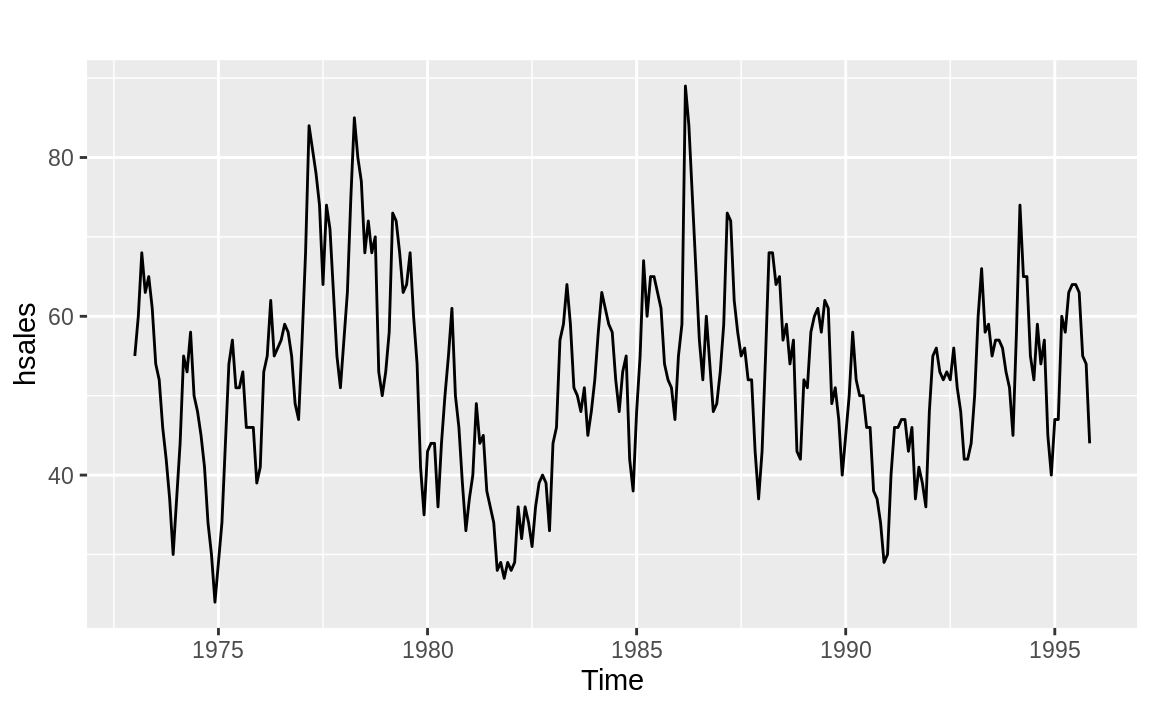
Figure 14.19: Time series with mean reversion
The example data here comes from the fpp2 package and comprises all Time-Series object types. If your data were in a zoo or xts object, then you would need to call coredata to extract out the raw data from the object before passing it to adf.test:
The adf.test function massages your data before performing the ADF test. First it automatically detrends your data, and then it recenters the data, giving it a mean of 0.
If either detrending or recentering is undesirable for your application, use the adfTest function in the fUnitRoots package instead:
With type = "nc", the function neither detrends nor recenters your data. With type = "c", the function recenters your data but does not detrend it.
Both the adf.test and the adfTest functions let you specify a lag value that controls the exact statistic they calculate. These functions provide reasonable defaults, but serious users should study the textbook description of the ADF test to determine the appropriate lag for their application.
See Also
The urca and CADFtest packages also implement tests for a unit root, which is the test for mean reversion. Be careful when comparing the tests from several packages. Each package can make slightly different assumptions, which can lead to puzzling differences in the results.
Smoothing a Time Series
Problem
You have a noisy time series. You want to smooth the data to eliminate the noise.
Solution
The KernSmooth package contains functions for smoothing. Use the dpill function to select an initial bandwidth parameter, and then use the locploy function to smooth the data:
Here, t is the time variable and y is the time series.
Discussion
The KernSmooth package is a standard part of the R distribution. It includes the locpoly function, which constructs, around each data point, a polynomial that is fitted to the nearby data points. These are called local polynomials. The local polynomials are strung together to create a smoothed version of the original data series.
The algorithm requires a bandwidth parameter to control the degree of smoothing. A small bandwidth means less smoothing, in which case the result follows the original data more closely. A large bandwidth means more smoothing, so the result contains less noise. The tricky part is choosing just the right bandwidth: not too small, not too large.
Fortunately, KernSmooth also includes the function dpill for estimating the appropriate bandwidth, and it works quite well. We recommend that you start with the dpill value and then experiment with values above and below that starting point. There is no magic formula here. You need to decide what level of smoothing works best in your application.
The following is an example of smoothing. We'll create some example data that is the sum of a simple sine wave and normally distributed "noise":
Both dpill and locpoly require a grid size—in other words, the number of points for which a local polynomial is constructed. We often use a grid size equal to the number of data points, which yields a fine resolution. The resulting time series is very smooth. You might use a smaller grid size if you want a coarser resolution or if you have a very large dataset:
The locpoly function performs the smoothing and returns a list. The y element of that list is the smoothed data:

Figure 14.20: Example time series plot
In Figure 14.20, the smoothed data is shown as a dashed line, while the solid line is our original example data. The figure demonstrates that locpoly did an excellent job of extracting the original sine wave.
See Also
The ksmooth, lowess, and HoltWinters functions in the base distribution can also perform smoothing. The expsmooth package implements exponential smoothing.
Source: https://rc2e.com/timeseriesanalysis
Posted by: ethelenecorzoe0197579.blogspot.com
Post a Comment for "R Data Analysis Cookbook Pdf Download"